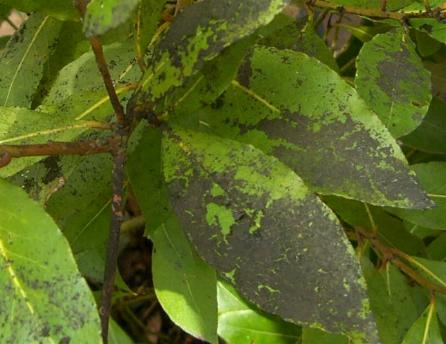
Sooty Mould on the leaves of a Bay tree infested with Scale Insects.
The Sooty Moulds arrive as a secondary infestation which feeds on the honeydew defecated by insects. Plants become blackened and are usually sticky. The fungi involved are saprophytic, ie. they do not invade the plant tissues, but remain on the surface. The mould is difficult to remove and although it is not feeding on the plant, it restricts the light reaching the leaves, thus reducing photosynthesis.
The initial cause is usually a sap-sucking insect like Aphids or Scale Insects. They excrete sugary droplets which coat the foliage and this honeydew is covered later with the black mould. The plant carrying the mould may not be the one which is infested with the sap-sucking pest, which may be on an overhanging tree or shrub. The mould is more likely to grow in dry conditions as rain washes the honeydew away.
It would be difficult to remove the black mould, especially in dry weather as it forms a hard crust on the leaves. Try to prevent it from forming by hosing the plant down to remove the honeydew. Find out the cause and treat with an insecticide or other preferred method. Scale insects are very waxy so a systemic insecticide is best. Lime trees usually carry a colony of aphids and scale, so plants and hedges below them are very prone to sooty mould. The tiny droplets are easily seen on the windscreen of a car parked under an affected tree, statuary, hard landscaping and garden furniture can become infested with sooty mould if the honeydew is not washed off.
Back to article on Plant Diseases